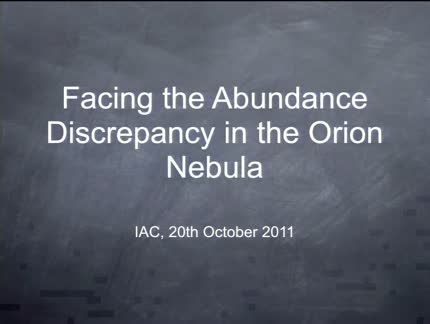Found 3 talks width keyword Orion Nebulae

Abstract
We present some results on a project based on high-resolution UVES@VLT spectroscopy and HST imaging of photoionized Herbig-Haro (HH) objects in the Orion Nebula. We study physical conditions, chemical abundances and other properties such as proper motions and the origin of the driving jets. Our study will include at least 9 HH objets, of which we will focus on HH529II, HH529III and HH204 in this talk. Our data allow us to separate the spectrum of the outflows from the main nebular emission, studying each object with an unprecedented detail. The HHs are located at different distances from the main ionization source of the Orion Nebula, with different ionization/physical conditions and flow velocities. In all objects, the electronic density (ne) is substantially higher than in the surrounding Orion Nebula, while the electronic temperature (Te) is maintained under photoionization equilibrium for the most abundant ion stages. In HH204 we observe a Te([OIII]) gradient due to the contribution of [OIII] emission from the cooling layer behind the bow shock, which is also detected in the HST imaging. The ionization degree of the gas in the different HH objects is very different, allowing us to determine the chemical composition of the Orion Nebula under both ionization conditions, avoiding the use of ionization correction factors (ICFs) for many elements. HH204 shows an abundance discrepancy -the difference between abundances derived from recombination and collisionally excited lines- thas is actually zero. We find direct evidence of dust destruction in the bow shock in all objects. This increases the gaseous abundances of Fe, Ni and Cr with respect to the Orion Nebula ones. We show that a failure to resolve the different kinematic components -as in a low spectral resolution spectrum- can lead to significant error in the determination of chemical abundances -40% underestimate of O in the case of HH204-, mainly due to incorrect estimation of the electron density.

Abstract

Abstract
The spectral analysis of HII regions allows one to determine the chemical composition of the ionized gas phase of the interstellar medium (ISM) from the solar neighborhood to the high-redshift galaxies. Therefore, it stands as an essential tool for our knowledge of the chemical evolution of the Universe. However, it turns out that chemical abundances of heavy-element ions determined from the bright collisionally excited lines (CELs) are systematically lower than the abundances derived from the faint recombination lines (RLs) emitted by the same ions. Today, this controversial issue is known as abundance discrepancy problem and it is far from negligible. In the analysis of Galactic and extragalactic HII regions the O2+/H+ ratio calculated from the OII RLs is between 0.10 and 0.35 dex higher than that obtained from the [OIII] CELs. In this talk, we will face this problem in the benchmark object of the solar vicinity, the Orion Nebula. Due to its high surface brightness and proximity, the Orion Nebula is an ideal lab, which allows us to study in detail the possible role of its rich and well-resolved internal structure (such as Herbig-Haro objects, protoplanetary disks or bars) on the abundance discrepancy.
« Newer Older »
Próximas charlas
- HOY: Quantum Simulators for the Cosmos: From Confining Strings to the Early UniverseDr. Enrique Rico OrtegaThursday December 4, 2025 - 10:30 GMT (GTC)
- Colloquium by Junbo ZhangDr. Junbo ZhangThursday December 11, 2025 - 10:30 GMT (Aula)









